Terrific Tuna
Canned tuna doesn’t normally elicit a whole lot of excitement. Mostly, you grab it mindlessly out of the cupboard because it’s convenient for making a quick salad, sandwich or casserole that you’ve made a hundred times before.
But imagine a canned tuna that actually makes you sit up and take notice not only because it has really deep seafood flavor, but also because it is low in mercury and is caught in a sustainable way.
That’s what Raincoast Trading canned tuna is all about.
Indeed, Greenpeace Canada just released its first sustainability ranking of 14 major canned tuna brands. Only two garnered a passing grade: Wild Planet Foods and Raincoast Trading.
The Vancouver, Canada company is run by a fourth-generation fishing family that catches wild-caught tuna and salmon in the Pacific Northwest. Each batch of tuna is tested for mercury, a heavy metal present in almost all seafood that can be harmful in large doses for pregnant women, nursing mothers and young children. The amount of mercury in Raincoast Trading’s tuna registers well below the allowable levels in the United States and Canada, according to a company spokesperson.
Albacore tuna are caught by “hook and line” at a specific size to ensure that they are lower in mercury as the larger and older a fish gets, the more likely it will have higher levels of the toxic metal. Salmon are caught with portable fishing traps that apparently lessen the problem of catching other, unwanted fish at the same time.
Recently, I had a chance to try samples of the canned albacore tuna and sockeye salmon.
The first thing you notice when you open the can is that there’s very little liquid to drain out. Unlike most other canned seafood, no extra water or oil is added to these products. They are packed only in their own oils. The tuna and salmon also are “single-cooked” as opposed to the double-cooking that other canned seafood undergoes to make the skin easier to remove, but which can dampen the flavor and texture of the flesh.
Take a taste and you actually taste tuna as opposed to salt. A 1/3 cup serving has 25 mg sodium, compared to the 250 mg sodium per 1/4 cup serving of another popular brand of tuna I had in my cupboard at home. You can really taste the difference, too. There’s real flavor to the tuna, which is also nicely meaty in texture.
Raincoast Trading’s canned skinless, boneless Sockeye salmon has succulent flesh with a very rich salmon flavor. It would be dynamite in chowder.
You can find Raincoast Trading’s products at Whole Foods markets for $2.99 to $5.99, depending upon the type of seafood.
The canned salmon made for the star of a simple green salad that I dressed with a lemon vinaigrette with capers. As for the tuna, I decided to marry it with pasta in this fabulous dish from the January/February 2011 issue of Cook’s Illustrated magazine.
“Spaghetti with Lemon and Olive Oil” is actually a meatless dish. But lemon and seafood go so splendidly together that I figured it would work in this dish.
This pasta couldn’t be easier or faster to make. After cooking the noodles and draining them, you can make the sauce in mere minutes in the same pot. It’s just sauteed shallots mixed with some of the pasta cooking water, a little heavy cream, a splash of olive oil, lemon zest, lemon juice and grated Parmesan cheese. Then, I flaked in the tuna.
The result is a creamy, silky sauce — just enough to cling to the spaghetti strands, but not so much as to pool at the bottom of the bowl. The flavor is citrusy from the lemons and fruity from the olive oil, but not overpoweringly tart at all.
The tuna makes the dish more substantial, but also lessens the punch of the lemon a tad. So if you prefer more full-on lemon flavor, just make the recipe without it, as it appeared in the magazine originally.
Spaghetti with Lemon and Olive Oil
(Serves 4 to 6)
Note: Let the dish rest briefly before serving to the flavors develop and the sauce thickens
Table salt
1 pound spaghetti
1/4 cup extra-virgin olive oil, plus more for serving
1 medium shallot, minced (about 3 tablespoons)
1/4 cup heavy cream
2 teaspoons finely grated zest and 1/4 cup juice from 3 lemons
1 ounce finely grated Parmesan cheese (about 1/2 cup), plus more for serving
Ground black pepper
Two (5.3-ounce) cans tuna (drained, if using tuna packed in oil or water; if using Raincoast Trading brand, you don’t have to drain); optional
2 tablespoons shredded fresh basil leaves
Bring 4 quarts water to a boil in a large Dutch oven over high heat. Add 1 tablespoon salt and pasta to boiling water, cook, stirring frequently, until al dente. Reserve 1 3/4 cups cooking water, drain pasta into colander, and set aside.
Heat 1 tablespoon oil in now-empty Dutch oven over medium heat until shimmering. Add shallot and 1/2 teaspoon salt; cook until shallot is softened, about 2 minutes. Whisk 1 1/2 cups of reserved pasta cooking water and cream into pot; bring to a simmer and cook for 2 minutes. Remove pot from heat, return pasta, and stir until coated. Stir in remaining 3 tablespoons oil, lemon zest, lemon juice, cheese, 1/2 teaspoon pepper and the tuna.
Cover and let pasta stand 2 minutes, tossing frequently and adjusting consistency with remaining 1/4 cup reserved pasta water if necessary. Stir in basil and season with salt and pepper to taste. Serve, drizzling individual portions with oil and sprinkling with cheese.
Adapted from a recipe published in Cook’s Illustrated magazine, January/February 2011
Another Tuna Dish: Campanile Tuna Noodle Casserole

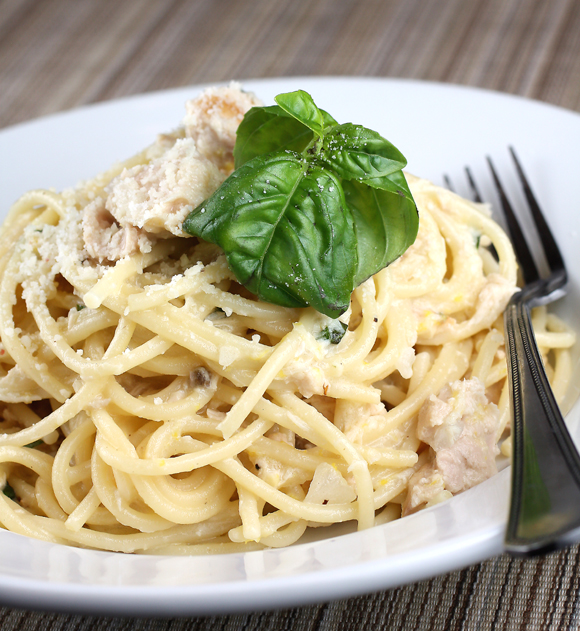
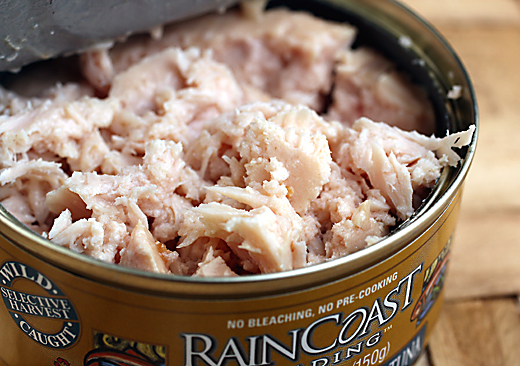
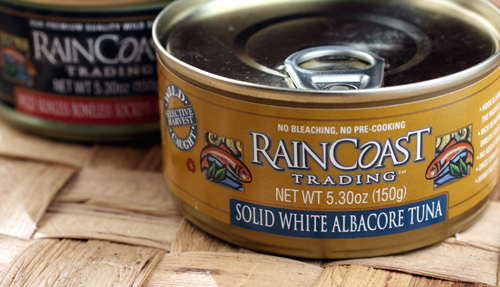
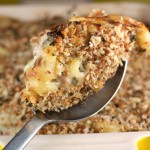
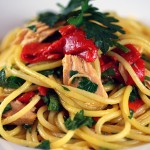
Good canned tuna is hard to come by, most taste like cardboard to me but thank you so much for the heads up on this brand of tuna…hope i find it in Texas, Oklahoma or Arkansas so I can try it. It’s also reassuring to know that they test each batch for mercury levels.
Sounds like sustainable and delicious canned seafood, which I’m always looking for. The pasta dish sounds wonderful.
A very appetizing dish! That tuna looks delicious.
Cheers,
Rosa
There is something about lemon and pasta that is just magical. Thank you for sharing this tuna, too! I’m really excited to try it and will plan on picking some up from Whole Foods this weekend.
I resort to can tuna as a quick hit of protein in the past, so it’s nice to see quality options out there (even though you’re probably paying double the price). I like the idea of quality canned salmon because sometimes I can’t find good fresh salmon at the stores that’s NOT farmed. Canned salmon is typically fresh from the sea and not farm-raised, and that’s also a plus.
I haven’t had canned tuna in eons for obvious reasons but this brand is tempting me to try it out. The canned salmon sounds terrific too.
Single Guy Ben: One reason you probably don’t find wild fresh salmon all the time is because it’s very much a seasonal item. Just like asparagus is found in spring and peaches in summer, wild Alaska salmon is found in stores during its season — generally May through October. Wild salmon also costs a lot more than farmed, so that’s why some stores might opt to carry the cheaper version instead.
There are some differences between canned fish isn’t there! I tried an amazing tinned organic trout-it was heavenly! 😀
not sure it qualifies as sustainable, but we’ve been eating Dave’s Tuna because it tastes so much better than the major brands. Dave’s is “hook and line caught” and canned in Santa Cruz, CA. Nothing added and it lists 43g of Sodium in a 7.75 oz can. We’ve found it at Cosentino’s and at a booth at the Cambell farmers’ market. I have no connection to Daves, btw. http://www.davesalbacore.com
Pingback: Tweets that mention Food Gal » Blog Archiv » Terrific Tuna -- Topsy.com
This is such great news. I’ve been using American tuna which is another line caught option, but it’s not easy to find. Great to hear that this one gets a passing grade from Greenpeace Canada. I’ll look for it!
This is a far cry from the tuna of my childhood. Thanks for the heads up. Incidentally, after your timely posts on ginger ales and sauerkraut, F&W had mentions to both (and a full article on the sauerkraut). Thanks for being ahead of the game!
Alton Brown spoke rhapsodically about Ventresca tuna (that’s a type, not a brand). Very expensive — something like $16 a can — but delicious. Fresh, not fishy.
Gosh, now I do yearn for a good pasta! Will look out for these when I get over to US next month!
I’m usually always frustrated having to wait for all the water to drain out of the can or suffer through mushy fish. This sounds fantastic and I’ll definitely check it out next time I’m at WF.
Thank you for bringing attention to the tuna sustainability issue. With all the recent attention to this issue http://www.kqed.org/a/forum/R201102041000
it really makes one think about all their food choices!
Ha!
Now i know what i’m gonna do with my tuna leftovers from last night. Make pasta! Like NOW. Because your post just made me drool 😉
Carolyn thanks so much for the tuna suggestion — to be honest I haven’t bought tuna in cans for years because frankly, I find the consistency and flavor often mushy and metallic. I will have to try the brand you suggested and make this beautiful beautiful pasta.
Thanks so much for sharing, you rock :)!
This sounds like a wonderful product for our bodies and the environment. Looks like a delicious pasta dish too!
For me, it is gonna be sardines-and-pasta toss, as I seldom get canned tuna.
Thanks for alerting us to this great product; I am always buying canned tuna for mindless sustenance in a snap but lamenting its lack of flavor; I cannot wait to try this one! Hope I can find it in Dallas.
Your dishes look yum … loved the presentation of the food ! good work
you can view some of my dishes on http://kitchensojourn.blogspot.com ! i would be really happy if you follow it 🙂
This pasta with tuna and lemon sounds perfect. This brand sounds like its definitely worth trying. Thanks for shairng
Pingback: Food Gal » Blog Archiv » Chef Anne Burrell’s Broccoli Rabe Pesto & A Food Gal Giveaway
Pingback: How does your tuna stack up?
Im a little late to this blog, but having eaten tuna straight out of the can for the last 10 years, I can say without a doubt that this is the BEST tuna I have ever had from a can. It is moist, and has great texture and flavor. If restaurants used high grade canned tuna, this would be it. It is expensive, but WORTH every penny (think about how much money you spend per day on Starbucks!).
Pingback: Terrific Tuna – My blog